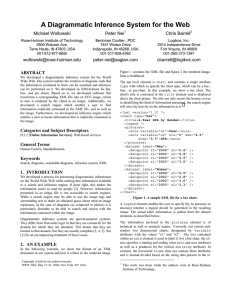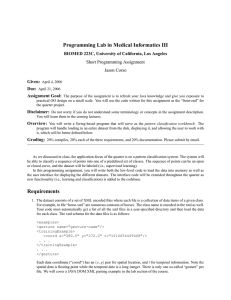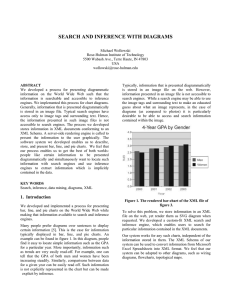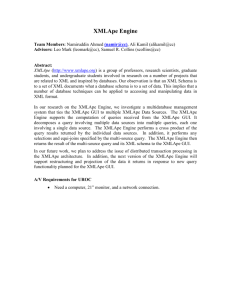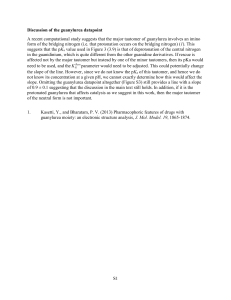Search and Inference with Diagrams Michael Wollowski, Ph.D.
advertisement
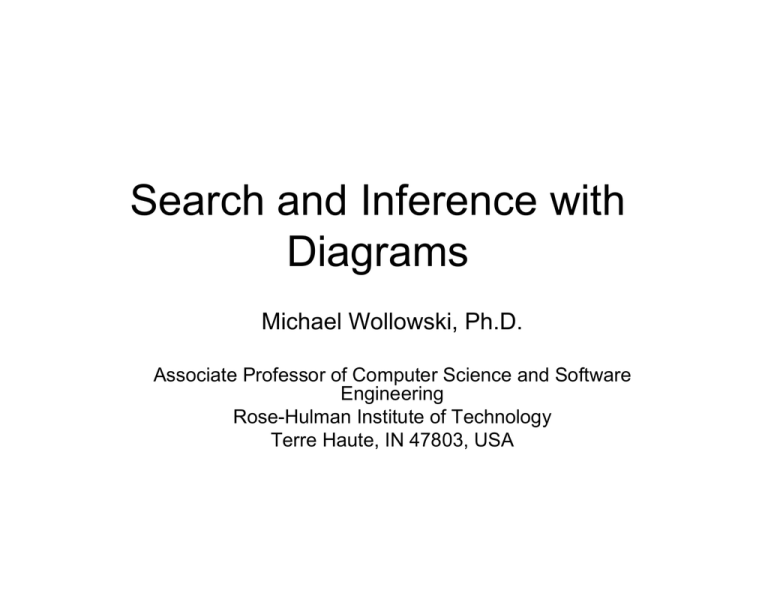
Search and Inference with Diagrams Michael Wollowski, Ph.D. Associate Professor of Computer Science and Software Engineering Rose-Hulman Institute of Technology Terre Haute, IN 47803, USA Motivation • • • • Search engines search text People prefer diagrammatic representations Diagrams are typically stored as image files Information in image files cannot be searched Sample Diagram Outline • • • • • • Approach taken Theoretical background Sample document Search engine Inference engine Conclusions Approach XML • Represent information in XML format • Render XML files as charts • Provide custom-fit search and inference engine Process XML File Contains information and meta-data Stored on web server; accessible to search engine SVG File Display data Server-side processing (when file is requested) Client-side display Benefits of our Approach • Information is semantically annotated • Information is accessible to search and inference engines • Diagrams help people extract information Theoretical Background • People successfully use charts to represent and extract information • Charts are highly structured, as such a syntax can be given for them just like for FOL • A semantics for charts can be given either directly or by correspondence Sample XML Document <?xml version="1.0" ?> <chart type="bar"> <title>4-Year GPA by Gender</title> <legend /> <plotarea> <axis variable=”x1”>Year</axis> <axis variable=”x2” min="0" max="4.0" step="0.5">GPA</axis> </plotarea> <dataset label="Men"> <datapoint x1="2000" x2="2.6" /> <datapoint x1="2001" x2="2.8" /> <datapoint x1="2002" x2="2.9" /> <datapoint x1="2003" x2="3.0" /> </dataset> <dataset label="Women"> <datapoint x1="2000" x2="2.5" /> <datapoint x1="2001" x2="2.8" /> <datapoint x1="2002" x2="3.0" /> <datapoint x1="2003" x2="3.1" /> </dataset> </chart> Document Rendered Correspondence of XML and Diagram <?xml version="1.0" ?> <chart type="bar"> <title>4-Year GPA by Gender</title> <legend /> <plotarea> <axis variable=”x1”>Year</axis> <axis variable=”x2” min="0" max="4.0" step="0.5">GPA</axis> </plotarea> <dataset label="Men"> <datapoint x1="2000" x2="2.6" /> <datapoint x1="2001" x2="2.8" /> <datapoint x1="2002" x2="2.9" /> <datapoint x1="2003" x2="3.0" /> </dataset> <dataset label="Women"> <datapoint x1="2000" x2="2.5" /> <datapoint x1="2001" x2="2.8" /> <datapoint x1="2002" x2="3.0" /> <datapoint x1="2003" x2="3.1" /> </dataset> </chart> Key XML Components • • • • • Datapoint element for each piece of data Dataset elements enclose & label datapoints Title and legend elements for annotations Plotarea specifies axis labels and decoration Chart type element to specify kind of chart (bar, line, or pie chart) Software Components • XML Schema for 2D bar, line, and piecharts • Servlet that processes XML files and outputs SVG files • XSL stylesheet for invoking servlet • Sample files containing student information Interface to Search/Inference Engine Results Screen Key Ideas • Search engine takes advantage of semantic nature of elements • It locates explicitly contained information • Inference engine makes available implicitly contained information • It supports determining the: minimum, maximum, median, and average of data that satisfies a query, as well as whether the data increases or decreases Software Components • An XML search and inference engine servlet Conclusions • We developed a general process of storing diagrammatic information in a sentential format • Stored information is accessible to inference engines yet rendered as diagram • Our system is sufficiently general to store information that is typically displayed in bar, line, or pie-charts • We modified the XML Schema so that data from MS Spreadsheets can be automatically extracted to our XML format Future Work • 3D charts • Determining trends • Diagrams other than charts
